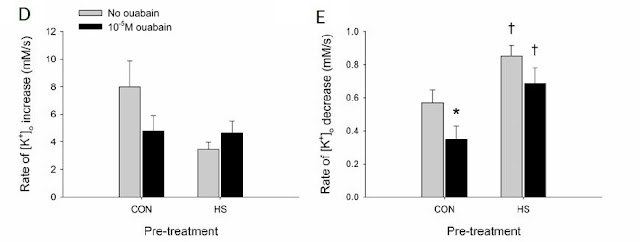 For every research project, there will always be a predecessor that led to the current project. Hopefully, there will also be a successor that follows the it. The paper that started my project was a paper published from our lab. In this paper, the researchers used the locust ventilatory central pattern generator (CPG) to study spread depression(SD)-like events. SD is closely associated with pathologies such as stroke, seizures, migraine and epilepsy. It is been characterized by a wave of electrohphysiological hyperactivity in the neurons followed by a wave inhibition.
For every research project, there will always be a predecessor that led to the current project. Hopefully, there will also be a successor that follows the it. The paper that started my project was a paper published from our lab. In this paper, the researchers used the locust ventilatory central pattern generator (CPG) to study spread depression(SD)-like events. SD is closely associated with pathologies such as stroke, seizures, migraine and epilepsy. It is been characterized by a wave of electrohphysiological hyperactivity in the neurons followed by a wave inhibition.In this experiment, neuronal hyperactivity is stimulated in locusts' ventilatory CPG by several stressors such as anoxia, ATP depletion, and hyperthermia. The neuronal acitivty is then monitored using K+ sensitive microelectrodes to measured the extracellular K+ concentration in the metathoracic neuropile of the CPG. In addition, CPG output is monitored electromyographically from muscle 161 to investigate the role K+ in failure of neural circuit operation induced by those stressors.
In this study, through using K+ sensitive microelectrodes and electromyographic electrodes, researchers found the stress-induced ventilatory pattern failure is tightly correlated with a abrupt increase in the extracellular potassium concentration. This suggested that the failure of ventilation in response to different stressors (hyperthermia, anoxia, ATP depletion, Na+/K+ ATPase impairment, K+ injection) was associated with a disturbance of CNS ion homeostasis. This disturbance in CNS ion homeostasis also shares the characteristics of cortical SD and SD-like events in vertebrates.
 |
| These figured illustrated the tight correlation between the failure in ventilatory CPG and the abrupt increase in the extracellular potassium concentration. Noticeably, locusts were able to recovery their ventilatory motor pattern once they have restored their extracellular potassium homeostasis. Vent: ventilatory motor pattern monitored using and EMG electrode, [K+]o: extracellular potassium concentration monitored using the K+-sensitive microelectrode. |
In addition, researchers found that heatshock delayed the onset of ventilatory pattern failure and shortened the time to restore Na+/K+ homeostasis and recovery of ventilatory pattern failure. The researchers found that this phenomenon is archived through an increased rate of extracellular potassium clearance by heatshock.
 |
| These two figure illustrated that HS decreased the rate of extracellular potassium accumulation and increased the rate of extracellular potassium clearance. This phenomenon hinted that after a HS pretreatment, locusts were better at restoring their potassium homeostasis. |
However, when researchers studied the mechanism behind this increasesd clearance rate, they found that it was not due an increase in Na+/K+-ATPase enzymatic activity in heatshocked locusts. They measured the production of NADH spectrophotometrically at 340 nm. The Na+/K+-ATPase activity was assessed using a pyruvate kinase/lactate dehydrogenase assay. In this experiment, both Na+/K+-ATPase and pyruvate kinase/lactate dehydrogenase assay required ATP. The pyruvate kinase/lactate dehydrogenase assay produces NADH, and will compete for ATP with Na+/K+-ATPase. If the ATPase had a higher enzymatic activity, then it would utilize ATP at a faster rate, minimizing the amount of ATP is used for the pyruvate kinase/lactate dehydrogenase, in return, decreases NADH production
In addition, researches examined the cellular ATP level in heatshocked and control animals. The ATP level in heatshocked and control animals was quantified using a luciferin-luciferase reaction. In this reaction, ATP is consumed and light is emitted when firefly luciferase catalyzes the oxidation of D-luciferin. Since ATP is the limiting reagent, the the amount of ATP present is proportional to the light emitted, which is measured using an Lmax luminometer. Each measurement of light intensity was compared to a standard curve generated using known quantities of ATP prepared in water. The end result illustrated that there was not a significant difference in cellular ATP concentration between control and heatshocked animals. This indicated that the lower clearance rate observed in control locusts was not due to a lower level ATP, which could hinder their Na+/K+-ATPase function.
 |
| This figure illustrated that there was no significant difference in cellular ATP level between control and heatshocked locusts at the same time. However, a significance was observed during anoxic period for both control and heatshocked locusts. |
This study concluded that when hyperthermic failure that was preconditioned by prior heat shock, it resulted in an induced-thermotolerance which was associated with an increase in the rate of clearance of extracellular K+. However, this increase in clearance rate was not linked to changes in ATP levels or total Na+/K+ ATPase activity. As a result, the mechanism behind this increased clearance remains unclear.
My project as one of the successors to this paper, is aimed to elucidate the underlying mechanism of this rate increase. The aim of my research project is to use fluorescence antibody to study whether the location/trafficking of the Na+/K+-ATPases differ between a control and heat-shocked locusts, which might have allowed heatshocked locusts to increase the amount of surface-bound, active ATPase on their membranes.
Reference:
Rodgers, C.I., Armstrong, G.A.B., Shoemaker, K.L., LaBrie, J.D., Moyes, C.D., Robertson, R.M., 2007. Stress preconditioning of spreading depression in the locust CNS. Public Library of Science. 12:e1366.
It is a very interesting information, I wasn't aware of the repercussions of his.Lactate Assay Kit
ReplyDeleteHey great work.. I loved this post..Thanks for sharing this information. <a href="http://bioassaysys.com/
ReplyDelete”> Acetylcholine Assay Kit
</a>
wow..its wonderfull .I like it very much..Thanks for sharing it.. Glucose assay Kit
ReplyDelete